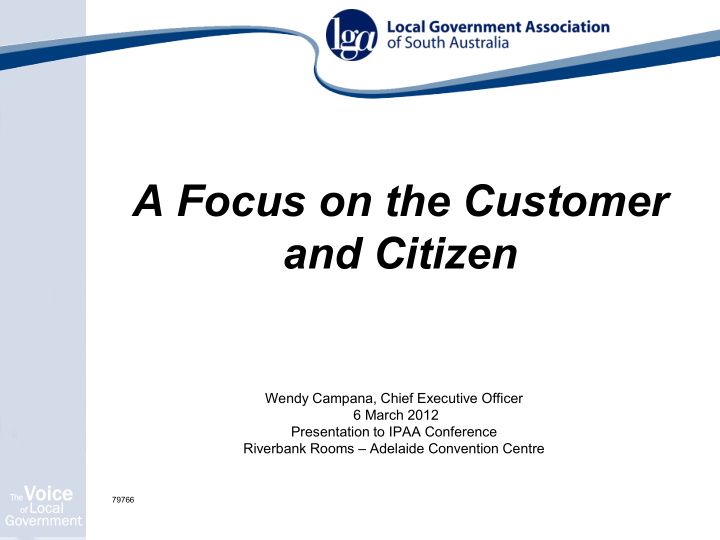



A Focus on the Customer and Citizen Wendy Campana, Chief Executive Officer 6 March 2012 Presentation to IPAA Conference Riverbank Rooms – Adelaide Convention Centre 79766
Local Government – Best Practice Consultation
The Context • 68 Councils • 714 Elected members • FTEs 8,350 • largest (Onkaparinga) – 163,000 pop • smallest (Walkerville) – 7,400 • Mt Gambier (largest country) – 26,000 • Orroroo Carieton (smallest country) – 930 • $17.75b infrastructure (2010)
What do we Consult on ? Examples: • Developments • Amendments to development plans • Service levels / new services • Rates – annually • Opening/closing pools, roads, parks, recreation centres • New libraries – closing old ones • Waste and recycling services • Strategic plans • Community land
What is the Context of the Issues? • local • regional • State-wide • my back yard • future strategic issues • costs
Are there Rules? • LG Act – Consultation Policy • LG Act – specific provisions (rates) • Council meetings – open to the public • Media present • Staff reports to Council Members • Council Members – elected
Some Differences Between Governments Budgets: • State/Federal Govts lock media out • LG has the discussion 3 to 4 months out Other decisions: • Cabinet all behind closed doors • Councils – limited “in confidence” provisions
What’s in the Tool Box? • Public meetings • Letter drops • Focus groups • Independent surveys • Door knocking • Public notices • On-line panels • Smartphone aps (Snap/Send/Solve) • Face book • Twitter
International Association for Public Participation (IPA2) • Informing – one way to assist understanding • Consulting – two way to get feedback on rationale, alternatives, proposals – informing decision making • Involving – process designed to identify issues, views, concerns and aspirations – prior to decision making • Collaborating – working together to understand all issues, interests, alternatives and identify preferred solutions • Empower – contribute to solutions – value local talent, skills, capacity to be decision makers
Phases for Community Engagement 1. planning for community engagement 2. development of a strategy 3. implementation of the strategy 4. providing feedback 5. final evaluation
Phase 1: Planning for Community Engagement Step 1 - Work with decision makers Step 2 - Clarify the decision to be made Step 3 - Identify key stakeholders Step 4 - Consider legislative requirements Step 5 - Select a level of community engagement Step 6 - Set up and maintain a community engagement record Step 7 - Establish evaluation measures.
Phase 2: Developing a community engagement strategy Step 1 - Gather and record background information Step 2 - Define community engagement objectives Step 3 - Establish community engagement parameters Step 4 - Identify key issues/interests and responses Step 5 - Select suitable techniques for community engagement Step 6 - Evaluate Phase Two
Phase 3: Implementing the Strategy Step 1 - Develop an Action Plan Step 2 - Complete a Task Breakdown Step 3 - Evaluate Phase Three
Phase 4: Providing Feedback Step 1 - Collate and analyse information Step 2 - Prepare a Feedback Report for stakeholders Step 3 - Prepare a Report for Council Step 4 - Implementation of the final decision Step 5 - Evaluate Phase Four
Phase 5: Final Evaluation Step 1 - Compile final evaluation report Step 2 - Write the final evaluation report
Local Excellence Program Themes: • Community engagement • Financial Reform • Service Efficiency & Effectiveness • Governance
New Initiatives under Local Excellence • LGA My services Ap • EARS • Engaging Multicultural & Aboriginal Communities • Social Media • Baby Boomers • Model Communications Plan • Early Childhood Development • Civics Education • Grievance Procedures/Management
New Initiatives under Local Excellence (continued) • Volunteers • Website upgrades • Service Level Standards • Red Tape Reduction • Benchmarking / Performance measurement • Workforce planning • T&D • Use of software/IT • Broadband
Thank You Questions ?
Recommend
More recommend